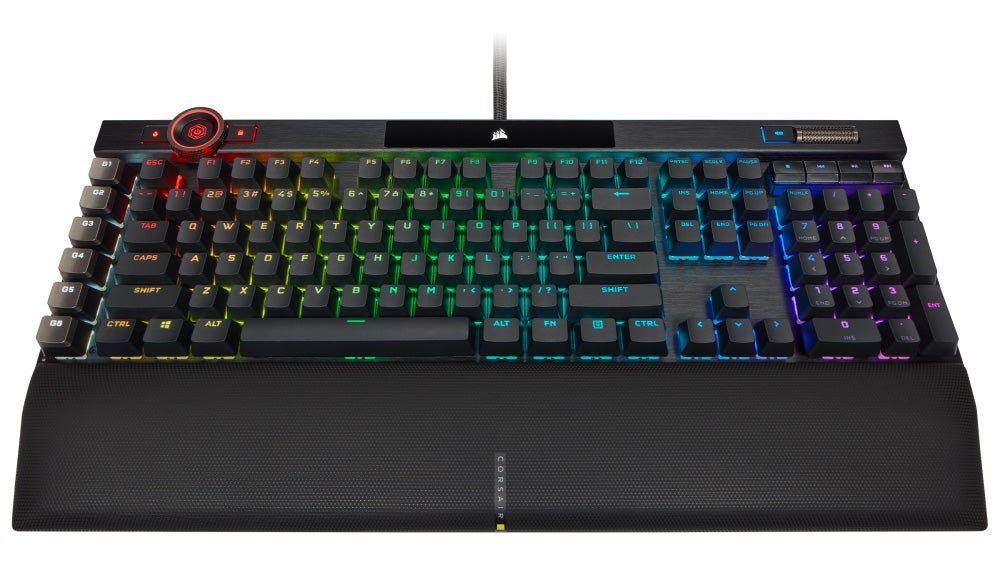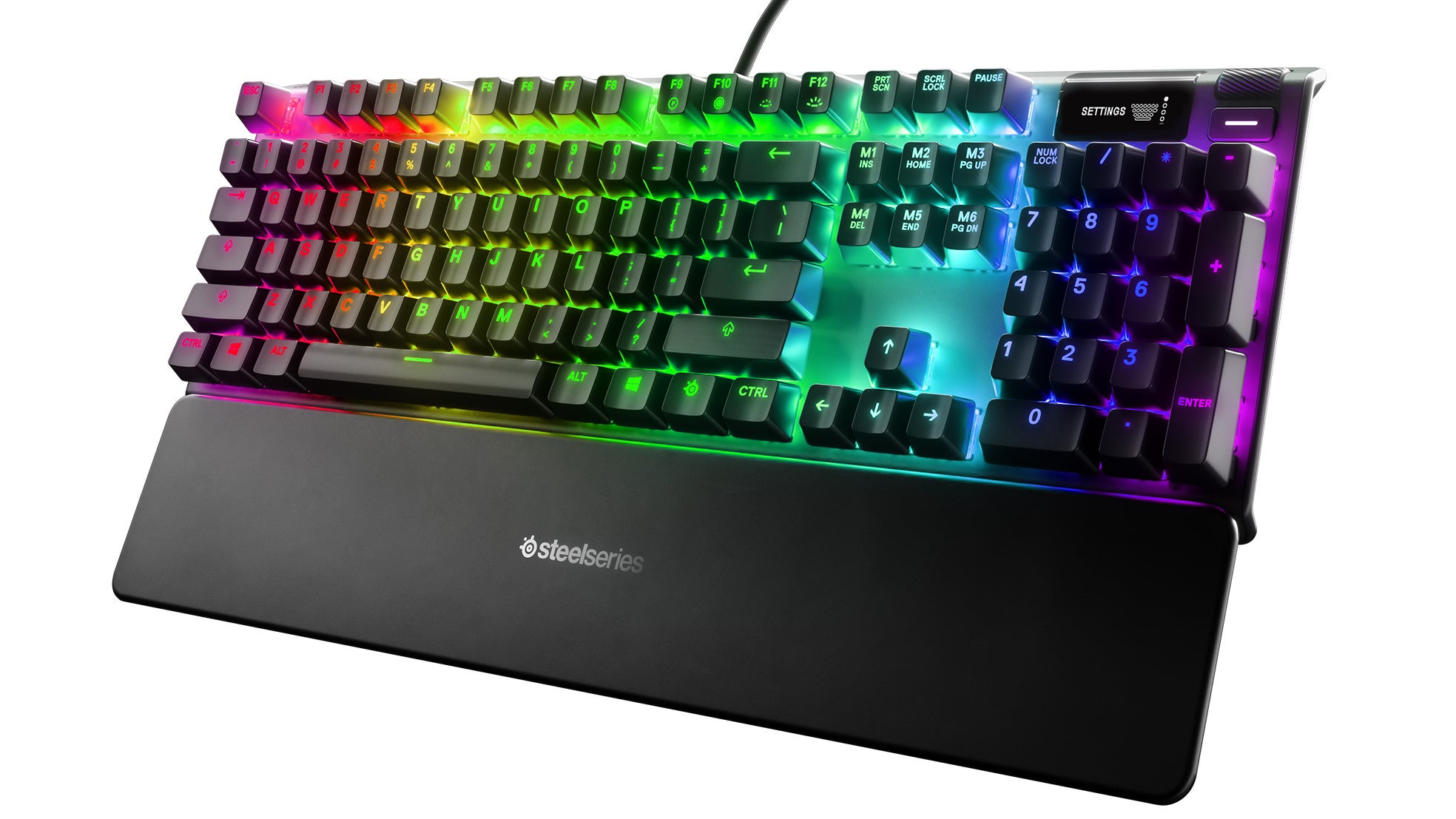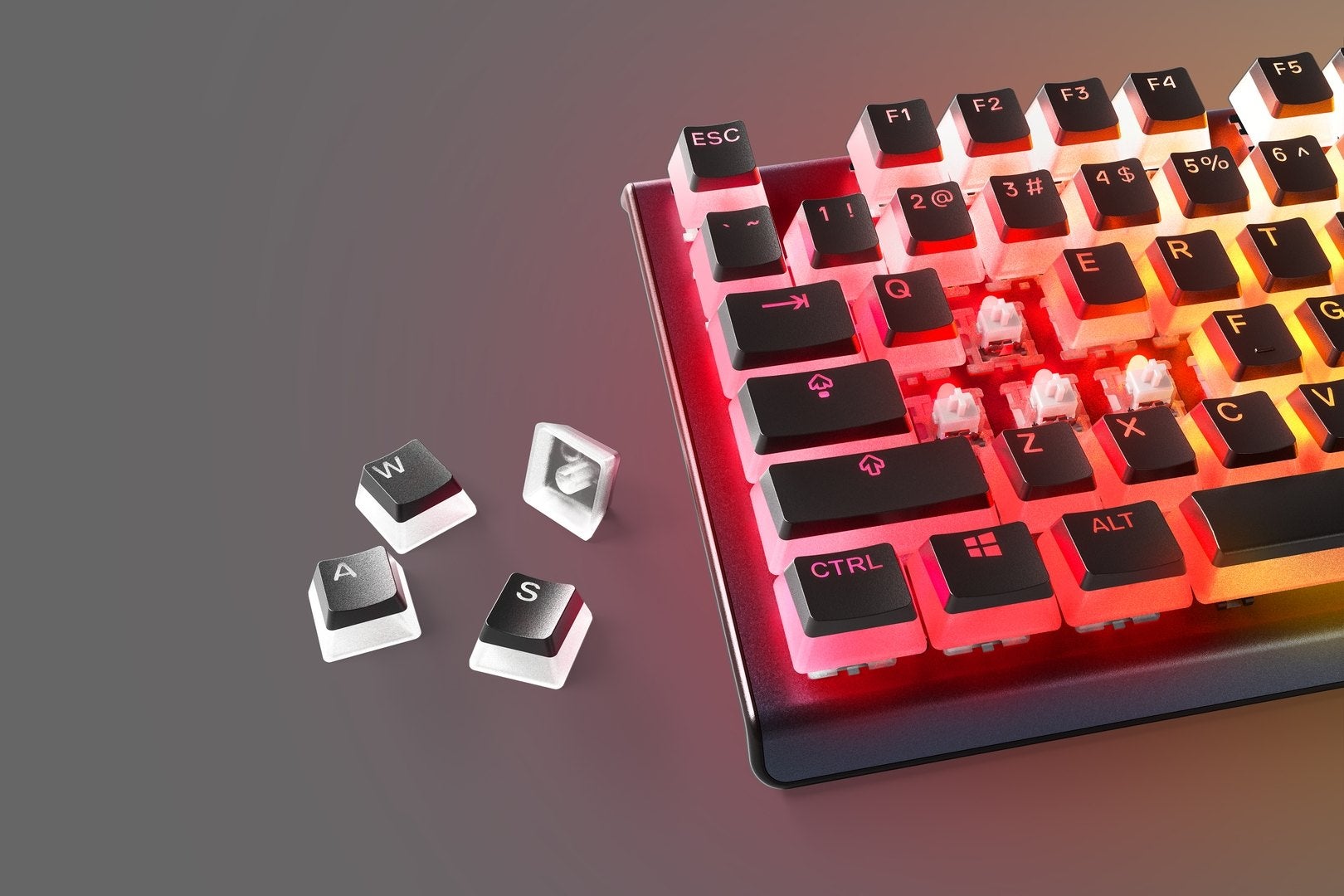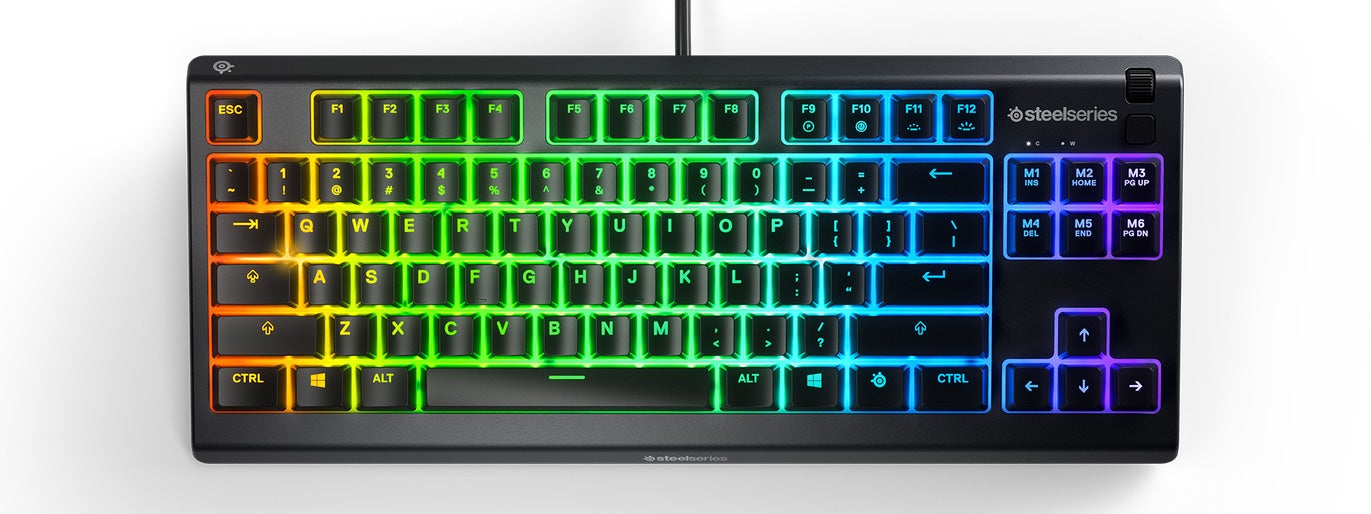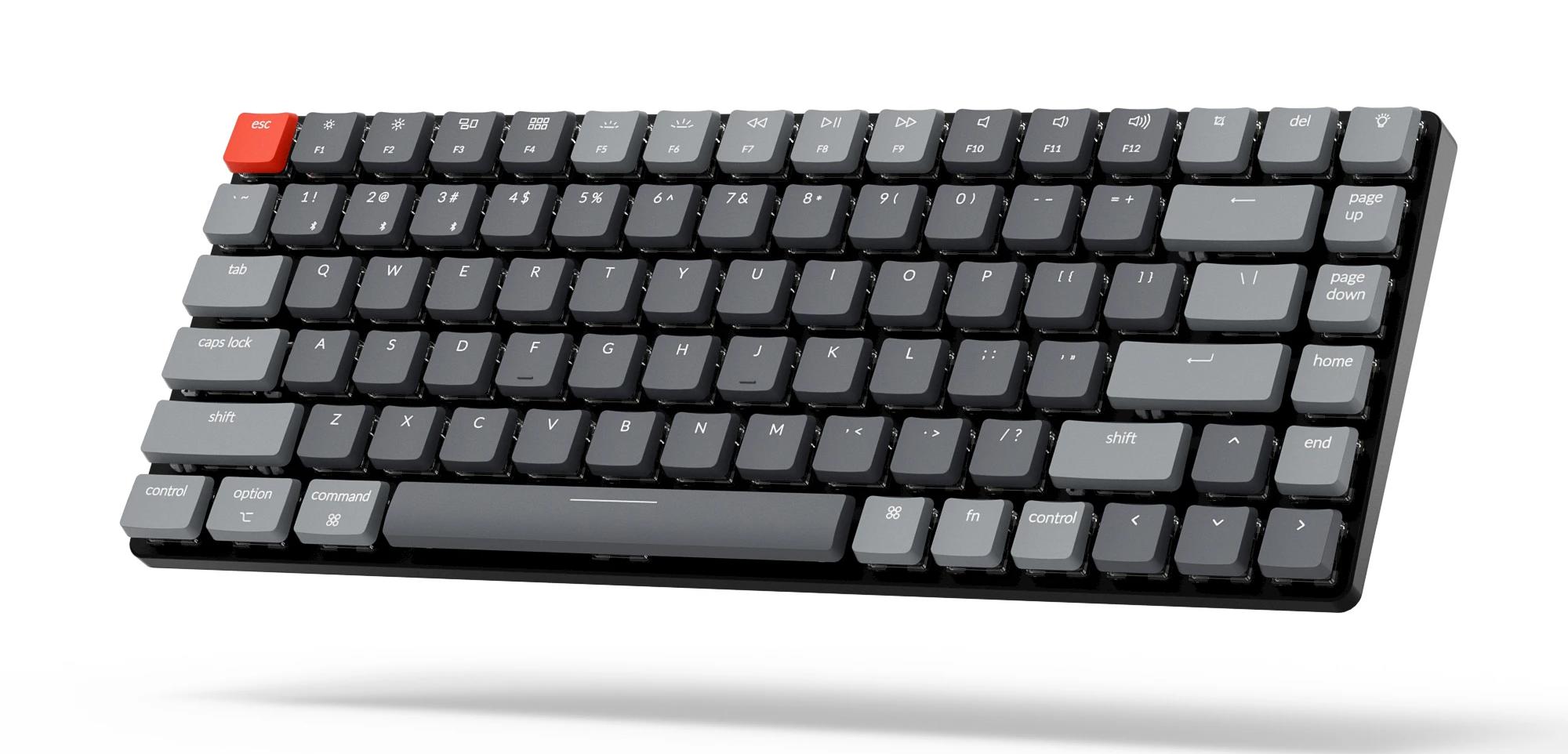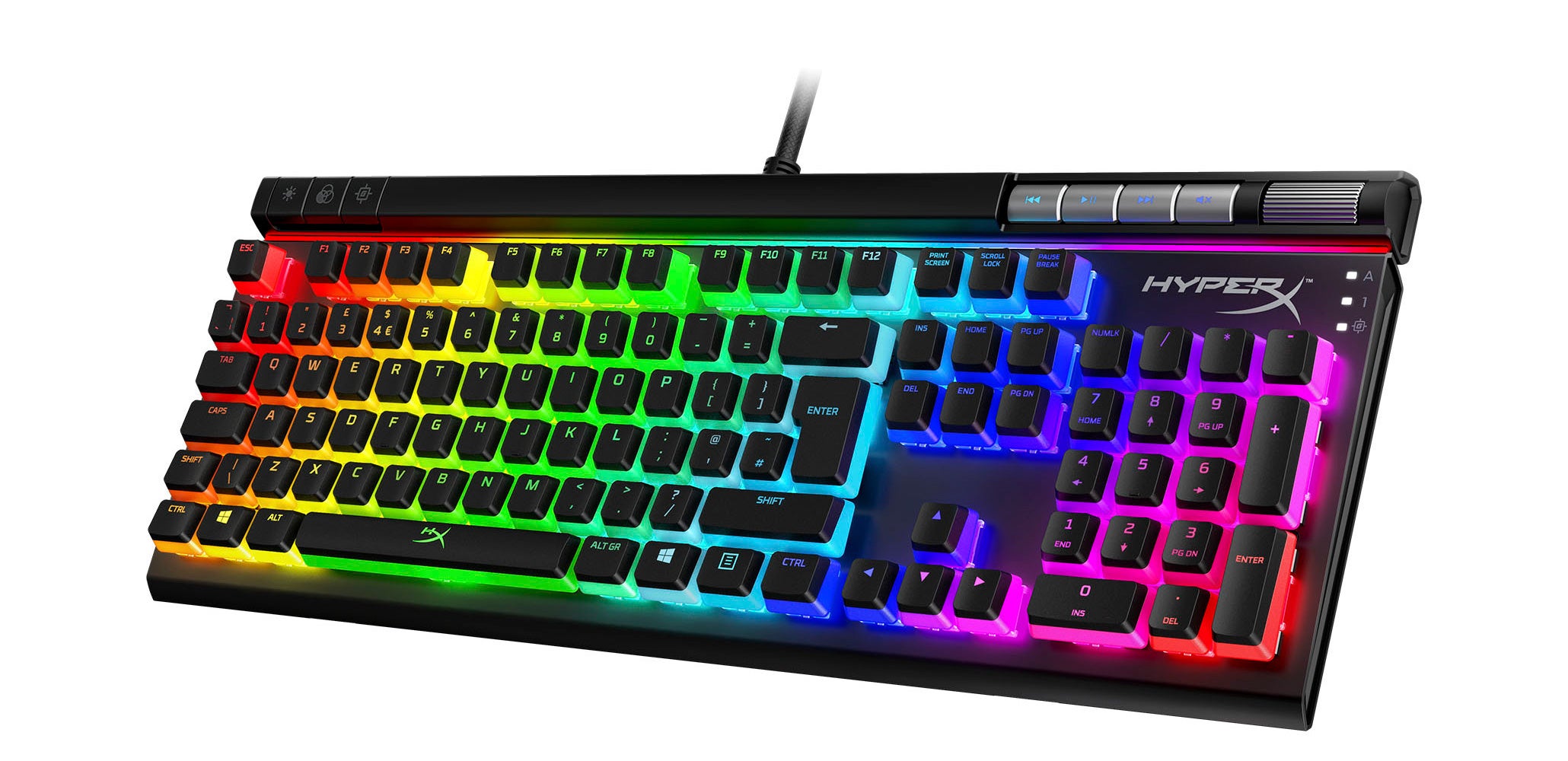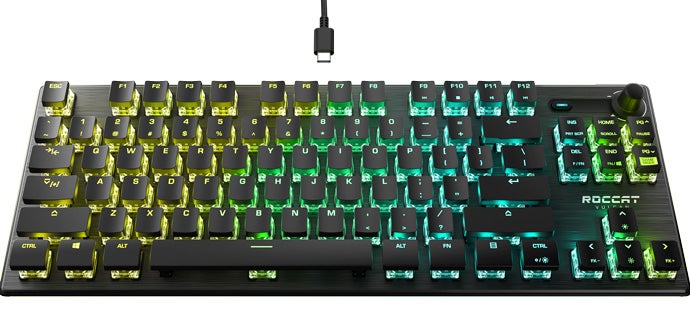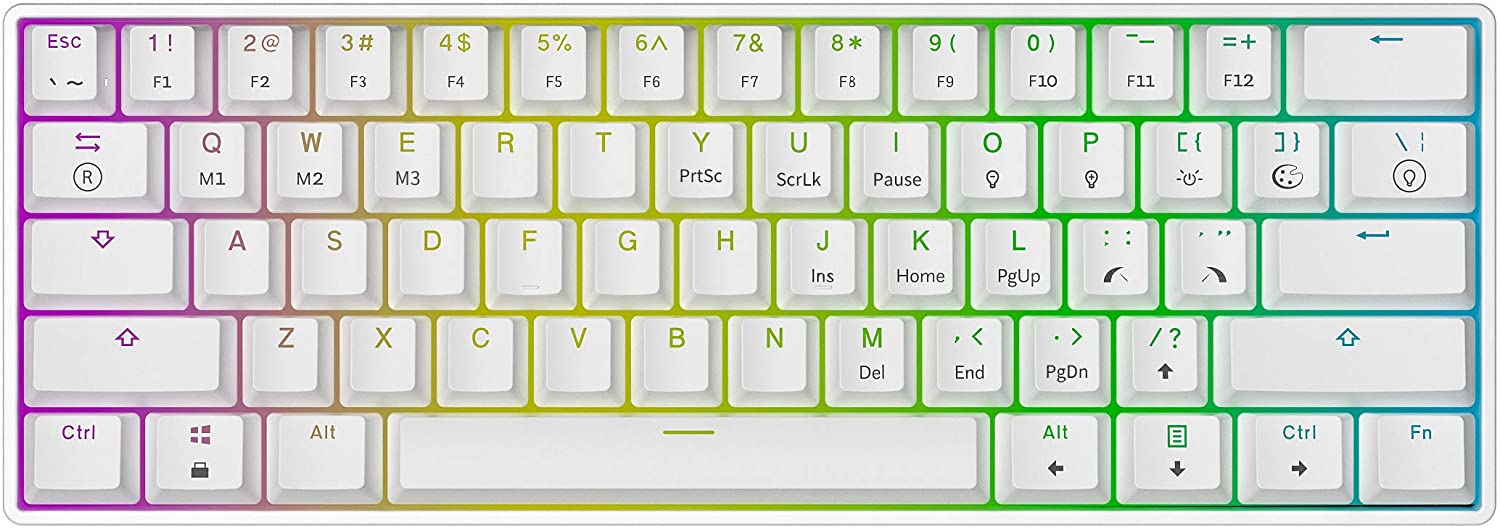Whether you prefer a simple non-mechanical keyboard that nails the essentials or a full-fat mechanical option that brings all of the best features too, you’re sure to find something that appeals within our top recommendations. We’ve tried to ensure that each of the twelve options here are distinct, rather than variations on the same theme. With a bit of luck, you’ll find some great new brands and keyboards here that you may not have even heard of, let alone considered. Why take my word for it? Image credit: Input Club I’ve exhaustively tested each of the keyboards on this list - and many more that didn’t make the cut. I’ve been reviewing gaming keyboards for years, from the rebirth of the mechanical keyboard almost a decade ago to the RGB-encrusted examples with unique switches and crazy features hitting the market as we continue into the halcyon days of 2022. It can be hard to keep up with the rapid pace of innovation in this unassuming space, so allow me to be your guide. Of course, it goes without saying that while there are certainly better and worse keyboards on the market, choosing the right keyboard is also a very personal experience. We’ve tried to consider a range of viewpoints and value judgements, but my number one choice might be one you wouldn’t even consider. Keep an open mind as you go through the selections, and feel free to chime in with your own questions or recommendations in the comments. We’ll continue to update this article over time, and the more feedback we get, the better we can make it! With that out of the way, let’s get straight to the top twelve picks. Click the links below to jump straight to those entries, or scroll on to read our full recommendations!
Full-size with dedicated media controls, volume wheel and multi-function wheel Cherry MX Speed or OPX optical mechanical switches, ideal for gaming Best-in-class software for recording macros, rebinding keys and adjusting RGB lighting
Corsair has a proud history of creating all-out mechanical keyboards with features that other manufacturers wouldn’t be able to copy for years, starting with the K90 way back in 2011 and K95 in 2014 - and now we’ve finally gone to the next tier with the K100. If you’ve used a high-end Corsair mechanical keyboard, the K100 is a logical evolution that adds on a very cool new feature: a multi-function wheel capable of some surprising things. Like the K90 and K95, the K100 is a full-size keyboard with a num-pad, plus a dedicated column of macro keys on the left, media keys on the right and a volume wheel in the upper right corner. What’s new for the K100 is that second wheel in the upper left, which can be used for tons of different things - zooming in and out, scrolling vertically or horizontally, skipping tracks, launching programs, swapping apps and so on. You can press the button in the centre to switch between different functions, with a different colour denoting each mode. Everything can be customised in the company’s iCUE software, which remains the most comprehensive tool available for tweaking lighting effects, recording macros and rebinding keys. Corsair also owns Elgato, so expect tight integration with products like the Stream Deck as well. Aside from the wheel, the K100 offers other noticeable improvements over its predecessors. The new optical OPX switches feel great under the finger, with a pleasant report and near-instant recognition, thanks to the lack of a debounce delay and 4000Hz polling, and you can go for a Cherry MX Speed alternative if you prefer. The lighting effects look as good as ever, with rainbows shooting out of each key, the logo and new side channels too. You can even mount the recently-released iCue Nexus touch screen onto the keyboard if you want to adjust keyboard settings, see system stats or launch commonly-used programs. I set up a screen with buttons to launch TweetDeck or the Eurogamer CMS on one side and my current CPU and GPU temperatures on the other - fantastic. If you miss the classic Logitech G15, this is a really nice modern take on the same great idea. Overall, it’s easier to list off what the Corsair K100 can’t do than what it can do. If you have the desk space for a full-size-and-then-some keyboard and you’ll actually use its many many features, then the K100 is worth every penny of its premium asking price.
Adjustable actuation switches can be tuned for gaming or typing Bright RGB backlighting and beautiful design with a super extra OLED display Superb build quality and long feature list justifies the premium price
The SteelSeries Apex Pro is our new runner-up pick, thanks to its strong fundamentals and truly meaningful extras. The first thing you’re likely to notice is the OLED screen in the upper right, which allows you to see your in-game stats, chatters in Discord or the music you’re playing; it also lets you adjust settings using the convenient volume wheel nearby. This feature even makes it into the smaller TKL (tenkeyless) version, though the volume wheel is substantially thinner. Less obvious but more impressive are the magnetic sensors built into each switch, which allow the actuation point - the point at which a keypress is registered - to be set anywhere from a crazy-short 0.4mm to a super-deep 3.6mm. This lets you reap the responsiveness benefits of a “speed switch” keyboard for gaming, then swap back to a more standard feel for typing and general computer use with a push of a button. It sounds trite, but this really is like having two keyboards in one. As well as offering advanced features, the Apex Pro is just a nice keyboard to look at and to use. It feels well built, with an gently rounded aluminium alloy frame, and its bright RGB backlighting spills out of the large capital letters on each keycap. A USB pass-through port, elegant cable routing, intuitive companion software and a comfy palm rest complete the package. The ABS keycaps included in the box are fine, but SteelSeries also make Prismcaps - double-shot PBT keycaps in white or black that provide an even cooler look. These offer a slightly more textured matte finish and look fantastic, transitioning from opaque at the top to translucent further down. These keycaps can be used with other mechanicals too, so they’re worth picking up for any board that comes with cheap or boring keycaps. Alternatives exist from other brands too, under names like ‘pudding caps’.
Stylish floating keycaps, RGB and a clean aluminium design Cherry Viola switches are soft, silent and satisfying Relatively compact, despite the full-format layout with numpad
The K60 RGB Pro is perhaps Corsair’s most restrained keyboard to date, and a far cry for the gamer stylings that the brand has traditionally been known for - ever since the first K60 in 2011. Rather than contrasting colours and red highlights, the K60 uses a black anodised brushed aluminium chassis with low profile ABS keycaps lit by (optional) RGB backlighting. Inside, Cherry’s new Viola switches provide a pleasant amount of feedback while remaining smooth and linear with 2mm of total travel. They’re pretty quiet for a mechanical switch too, and the keyboard worked well for both gaming and typing in my testing. Apart from the novel switches, the K60 RGB Pro includes a full layout, including number pad, with media controls, Windows Lock and other functions built into a Function layer. That allows for a much smaller footprint than Corsair’s more comprehensive keyboards, like the K100 we recently recommended. We also appreciated the build quality of this keyboard; despite being rather thin the brushed aluminium top plate provides considerable rigidity. All things considered, it’s a solid evolution from Corsair that offers reasonable value at its $90/£110 RRP. There are three more K60 variants coming out too. The vanilla K60 offers the same features as the K60 except with single-colour (red) backlighting, the K60 Pro SE adds a wrist rest and PBT keycaps and finally the K60 Low Profile uses low profile switches for a more laptop-like feel. The Low Profile might actually be my favourite version, as the combination of rapid travel and crisp feedback makes it feel like you’re typing at a million miles an hour - and it looks super sleek too.
Membrane keys provide a soft, quiet feel perfect for shared spaces Eight-zone RGB lighting is bright and effective Key rollover remains a limitation for membrane keyboards
If you prefer the softer feel, quieter operation and lower cost of non-mechanical keyboards, the SteelSeries Apex 3 TKL is the best we’ve tested so far. The membrane switches offer a decent amount of tactile feedback but require a relatively strong touch compared to mechanical keyboards. Like the Roccat Magma, our previous pick, RGB LEDs shine through a layer of semi-frosted plastic, diffusing the light evenly across the keyboard, which looks great. The membrane keys are also water and dust resistant, with an IP32 rating that means they should survive a few spills - although something like sweetened tea or cola will probably gum up the works somewhat. In terms of extra features, this tenkeyless keyboard has a rare volume wheel in the upper right and a button that’s set to play/pause by default. This can be customised in the SteelSeries GG software, which also allows different lighting modes and key assignments. However, the keyboard does have one major disadvantage. Despite claiming “gaming-grade anti-ghosting technology”, the keyboard doesn’t offer as high a key rollover count as we’d expect. For example, with Q and W held down, you can’t press down 0, H, J, comma or period. This means the keyboard only has a rollover count of two (2KRO), and six is the standard for a good gaming keyboard. Sadly, this is often a downside to choosing membrane over mechanical, and is worth bearing in mind if you are a fast typer or play games that require a lot of simultaneous key presses (like rhythm games or co-op games with two players on a single keyboard).
Low profile optical switches in linear, tactile or clicky variants Minimalist, portable and Mac-friendly design with detachable USB-C cable Incredibly affordable for an optical switch keyboard
The Keychron K3 proves that don’t need to spend a lot to get a beautiful look, modern features and excellent build quality. The K3 uses rare low profile optical mechanical switches, with a choice of clicky, tactile or linear options. These, combined with the compact 75 percent layout, make for a typing experience akin to the best laptop keyboard you’ve ever used. The optical sensor built into each switch ensures key presses can be registered in an instant, equalling the responsiveness of much more expensive gaming keyboards like the Razer Huntsman TE we featured in a previous version of this article. Keychron’s optical switches are also hot-swappable, making it easy to replace a broken switch or change to an entirely different feel later on. (If you’re not sold on optical switches, then you can get regular Gateron low profile switches instead for a slightly lower cost, but note that these aren’t hot-swappable.) As well as performing well in games, the K3 is also one of the few Mac-friendly keyboards on the market, with both Mac and Windows keycaps available. If you ever have occasion to use a Mac, you’ll no doubt appreciate the hotkeys along the top row of the keyboard and the alternate Mac modifier keycaps. The keyboard should be used via USB-C for competitive gaming, but Bluetooth is also available with around 30 hours of battery life - so you can use it comfortably with the iPhone and iPad, in addition to a wide range of other computers and mobile devices. All in all, the Keychron K3’s compact size, excellent switches and overall aesthetic makes it one of our favourite keyboards for gaming or typing. This keyboard is also uniquely in-demand here at Digital Foundry’s Bristol office, and disappearing on many occasions because someone fancied using it for work. If that’s not a tacit recommendation, I don’t know what is!
Pudding keycaps made from provide a beautiful look Includes extra keys for media and lighting controls, plus a volume roller Full-size layout, but no palm rest or extra keycaps in this revision
The HyperX Alloy Elite 2 is one of those keyboards that you plug into your computer and instantly fall in love with. For me, that’s largely down to its pudding keycaps, which allow the bright RGB backlighting to shine through the sides of each keycap as well as the legend on the top. That creates a mesmerising sea of rainbow colours, making this one of the best-looking RGB keyboards on the planet. HyperX have sold their pudding caps separately for some time now, so it’s great to see them make the leap to including a similar design, albeit in ABS rather than PBT, as standard on a premium mechanical keyboard. While the keycaps are a big improvement, the Elite 2 doesn’t include some add-ons provided with the original Elite. There are no replacement keycaps for WASD and a palm rest doesn’t come in the box, although it’s clear that the frame is still engineered to accept one. I personally used neither of these, but if you do want a palm rest you might consider a third-party option instead. Despite these omissions, the Elite 2 still feels like a full package. The HyperX Red switches underneath each keycap perform well, providing a soft and linear feel that’s well suited for gaming, and there are dedicated buttons for adjusting the backlighting effect or brightness, toggling game mode and controlling media. A notched volume wheel is also provided in the upper right corner of the board, allowing you to make on-the-fly adjustments without needing to dive into a settings menu - handy when you’re listening for footsteps in Warzone. There are no dedicated macro keys here, but the revised Ngenuity software allows you to rebind other keys easily - as well as choosing from a wider range of lighting effects or simply set the backlight to a static colour. Altogether, the Elite 2 is a well-crafted full-size mechanical keyboard that ticks pretty much all the boxes.
Superior design, fitting a volume knob onto a compact TKL frame High performance optical linear mechanical switches Refined appearance, with strong RGB backlighting and anodised aluminium
I think I’m in love. The original Roccat Vulcan is and was a great keyboard, with its unique low-profile keycaps atop full-size mechanical switches, but the Vulcan TKL Pro takes things to a new level. The black anodised aluminium chassis looks super clean and as sturdy as anything, and the designers also managed to do something not generally possible on a TKL (no numpad) design - they snuck in a volume wheel and mute switch in the upper right. They had to remove the Print Screen, Scroll Lock and Pause keys to do it, relegating them to a Function layer, but in my book it’s 100 per cent the correct call as it provides unparalleled usability in this form factor. Elsewhere, the Vulcan TKL Pro ticks all the boxes. Roccat’s bespoke Titan Switch Optical provides a smooth, short linear action enhanced with optical keypress sensing, eliminating the need for the usual debounce stage that adds a few milliseconds to the time between a key being pressed by the user and that key being recognised by the computer. Does that actually make you a better gamer? Probably not, but the technology is legitimate and it certainly doesn’t hurt your performance. Likewise, the clear switch housing allows RGB light to spill across the keyboard, providing a wonderful glow at night - and don’t worry, you can choose a single colour if you prefer. You will need to dip into Roccat’s (powerful but poorly laid out) software to change colours and effects, but there is a shortcut to disable the backlight entirely should you need to. Altogether, the Vulcan TKL Pro is one of the most exciting keyboards I’ve used for a long time. It looks good, it feels great and it should last a long time. It provides genuinely useful features and doesn’t cost the earth - although at £150 RRP, it’s certainly on the premium end of the mechanical keyboard spectrum. Thankfully, if you don’t need optical switches, the standard Vulcan TKL is also available at £120. There’s also a full-size Vulcan Pro model at £180.
Analogue optical switches provide a rapid response and new gameplay possibilities Full-fat design with palm rest, volume wheel, RGB and more Not all games support analogue inputs cleanly; software could use more polish
The Razer Huntsman V2 Analog is the most advanced keyboard Razer has ever shipped. As well as the media keys, volume wheel and advanced RGB lighting that defines the Huntsman series, the Analog comes with unique optical switches, allowing the keyboard to sense not just whether a key has been pressed or not, but how far it has been pressed. This unlocks the door to unique capabilities, such as using keyboard keys as an analogue throttle in a racing game or changing between walking and running in a shooter by pressing down harder. You can also adjust the actuation point, the depth at which a press is registered, for example to have a very responsive keyboard for gaming and a more normal feel for typing. Finally, you can also set keys to have two functions; one for a light press and one for a heavy press, which allows you to trigger two actions in quick succession or at a delay depending on the situation; Razer’s review materials suggest equipping and then throwing a grenade as an example of an action that might work well set up like this. Not all games support simultaneous keyboard and gamepad input, required to use analogue keys, but in those that do the experience can be transformative. I had real fun exploring the possibilities, and if you’re willing to pay the premium price (£194/$250) I’m sure you will too. If you don’t need the analogue functionality, I’ve also tested and recommend the Huntsman V2 ($200/£200) and Huntsman V2 Tenkeyless ($160/£160). These keyboards comes with clicky optical purple or linear optical red switches with stabilisation on all keys - a rarity - and a clean ‘floating key’ design. I customised my V2 TKL with some of Razer’s recently released add-ons, including PBT keycaps and a matching coiled cable, and ended up with a unique-looking keyboard in glorious pink. Black, white and green sets are also available.
Non-mechanical membrane switches are soft and quiet Full-size layout with dedicated volume, media and macro keys Long battery life for a full RGB-backlit keyboard
It’s rare to see a truly premium non-mechanical keyboard these days, but that’s exactly what you get with the Corsair K57 Wireless. This keyboard uses Corsair’s low-latency Slipstream wireless tech which we enjoyed on the company’s recent gaming mice, and this is backed with Bluetooth and standard USB so it’s easy to connect to a wide range of devices from PCs to tablets and smartphones. We didn’t notice any performance penalty from using the Slipstream wireless connection, even in fast-paced games like CS:GO. Battery life is astonishing too, rated at up to 170 hours thanks to advanced RGB lighting and a sizeable battery. The keyboard feels nice under the finger too, with the membrane switches providing a soft landing and very quiet operation - ideal for family rooms and offices. The full-size layout offers everything you could want in terms of features, barring except a rolling volume wheel - instead, you’ll have to make do with only six macro keys, seven media controls and three other small buttons for recording new macros, adjusting the full RGB backlighting or locking the Windows key. Corsair’s iCUE software is on tap if you want it, with deep options for programming custom lighting patterns or interfacing with other apps and games. There’s even a nice wrist rest that echoes that found on the considerably more expensive Corsair K70 MK.2. All in all, a cool modern membrane keyboard that goes some way to justifying its nearly three-figure price tag. If you don’t want to have to bother with recharging your keyboard, the newer K55 Pro XT offers the same layout and features but with a simple wired connection; it should cost less in most regions. I found the membrane keys on my test unit to require a little bit more force than the K57, making typing more fatiguing, but it’s possible that the keyboard would break in over time. Unlike prior K55 models, the Pro XT does include per-key RGB backlighting and full access to Corsair’s iCUE software, providing a lot of interesting options for dynamic lighting, macro recording and key rebinding. If the two keyboards are at a similar price I would opt for the K57, but this is largely down to personal preference.
Full UK layout with function keys, RGB backlighting and clean design Outemu soft linear (Red) mechanical switches are ideal for gaming Not available outside of the UK
The ADX Firefight MK04 from Currys offers excellent value for money, offering a full set of 105 fully mechanical keys for less than £40. The keyboard looks and feels better than the price would suggest, with effective RGB backlighting, handy function keys and surprisingly clean aesthetic. The keyboard is a little loud, like other mechanicals, but the increase in feedback and longevity makes this small concession entirely worthwhile. This is a sterling introduction to mechanical keyboards at a very reasonable price. For US buyers, consider the similar Redragon K551 (full-size) and K552 (compact) keyboards, which come with clicky MX Blue style switches.
Metal construction and very gamer-y RGB look Very affordable, but only available in the UK and Europe RGB backlighting isn’t customisable
Membrane keyboards get a rap from mechanical keyboard fans, but some people just prefer the soft feel of a classic rubber dome board and there’s no denying that membrane boards can be a lot cheaper too. If that’s you, then a good inexpensive option to consider is the Trust Gaming GXT 856 Torac. The Torac offers a clear contrast against monochrome and rectangular office keyboards, with bright RGB backlighting and a metal frame that extends beyond that is strictly necessary. The labels on each key are easy to read, while a Function layer allows convenient access to media and volume controls. One potential gotcha is that the lighting here isn’t customisable, so you can’t set the keyboard to a single colour - each key will always light up in the same colour, unless the lighting is turned all the way down. Older users may prefer something a little more refined, but for the younger audience this keyboard seems to be pitched towards the Torac will do the job nicely.
Powerfully programmable RGB backlighting Compact 60 per cent size is convenient for gaming Available with red (linear), blue (clicky) or brown (tactile) Gateron switches
The Whirlwind FX Atom is a unique 60 per cent mechanical keyboard. The keyboard’s design and specifications are impressive for the price ($99), with front and top-labelled double shot ABS keycaps, a rare 3000Hz polling rate which can slightly reduce input delay and a detachable USB-C cable. The software is perhaps the most interesting feature, with Whirlwind FX claiming to offer lighting integrations for more than 50 games, and a kind of online marketplace that allows you to download or share user-made effects. The community feels a little small right now, but it’s a cool idea and the keyboard is a delight, so I hope we see it grow steadily over the time. After all, the more people contributing, the better the Atom will be able to deliver on its latent promise. UK alternative: Mizar MZ60 Luna Sadly, the Atom isn’t available in the UK, so our top 60 per cent size alternative is the Mizar MZ60 Luna (£60/$60). This keyboard lacks the advanced RGB software of the Whirlwind FX, but delivers exceptional build quality at its modest price point. The MZ60 Luna also has its own tricks, including hot swappable key switches that allow you to customise the feel, tactility and audible response of each key press - as well as easily replace any key switches that break or have soda spilled on them. The Luna matches the Atom with double shot ABS keycaps, detachable USB-C and a clean design that maximises the space available for your mouse. It depends! Mechanical keyboards feel better to type or game on for many people, and are sometimes described as faster or more responsive. While membrane keyboards harden over time, mechanical keyboards provide a consistent experience for decades. Mechanical keyboards are also available in many different switches, each of which has their own characteristics - loud versus quiet, tactile versus linear, long travel versus short travel and so on. However, mechanical switches are expensive to produce and often sound louder than their non-mechanical counterparts. By comparison, non-mechanical keyboards tend to feel softer, cost less to produce and don’t sound as loud. While both options have their objective strengths and weaknesses, it often comes down to personal preference. What types of mechanical keyboards are there? Mechanical keyboards are defined by their switches. The most common options are MX switches, originally made by Cherry and now made by a range of manufacturers. Each switch is described by its colour; the three most popular are as follows:
Blue: Clicky and tactile, with a relatively high actuation force Brown: Not clicky but still tactile, with a relatively low actuation force Red: Linear, not clicky or tactile, with a relatively low actuation force
Clicky feedback is fun and can make typing easier, but it can be annoying to others - especially if you’re in an shared space or streaming. Tactile feedback also makes it easier to know when a key has been pressed, which can be handy for typing or gaming. Linear switches eschew this added feedback, but operate more smoothly and are therefore most commonly selected for inclusion in gaming keyboards. As usual though, a lot of this comes down to personal preference so experimentation is key. Since mechanical keyboards became popular about ten years ago, there has been explosion in the numbers of mechanical switches available. Many peripheral producers, such as Razer and Logitech, now make their own proprietary switches which are takes on the original Cherry MX design. The most common modifications allow for faster keypresses (e.g. MX Speed Silver), quieter operation (e.g. MX Silent Red) and improved RGB backlighting (e.g. MX RGB Red). We’ve also seen the introduction of more major redesigns, such as including optical sensors in order to offer adjustable actuation points or full-fat analogue switches as in the Wooting One, above. Laptop-style Cherry ML switches are also becoming a thing. What types of non-mechanical keyboards are there? There are quite a few options, with the most common being traditional membrane keyboards that use a dome of rubber beneath each key to let you know that your key press has been recognised. Hybrid switches, sometimes described as ‘mecha-membrane’, attempt to provide additional tactile feedback, similar to a mechanical switch, without giving up the low cost and soft feel of a membrane. Scissor switches are another option, which provide a little more tactile feedback and a short travel distance, like you’d expect to find on a laptop. What is the point of keyboards that don’t include the number pad? Many keyboards, particularly mechanical ones, don’t include the number pad. This might be done for several reasons: to lower manufacturing costs by reducing the number of expensive mechanical switches included, to save space on crowded desks or to create a more portable design. However, the most important benefit of so-called ’tenkeyless’ designs is that of ergonomics: with no number pad, right-handed gamers can keep their mouse hand more in line with their arm. This position is easier to maintain over long periods - although regular breaks are always advised! - and puts less stress on the limbs and joints. There are also even more compact designs, i.e. 60% or 75%, which drop more keys in order to achieve even smaller sizes. Are there quiet mechanical keyboards? Yes. There are many keyboards on the market made with MX Silent Red switches, including options from Corsair, Fnatic and others. Some popular examples include the Fnatic Gear Rush, Fnatic MiniStreak, Corsair Strafe and Corsair K70 Lux; these keyboards and other quiet mechanical keyboards are linked below. However, no keyboard is completely silent, and these are no exception! Why do some keyboards have differently shaped Enter and Shift keys? In short, there are two major keyboard layouts in the world: ANSI for the US, China and some other regions, and ISO for the UK, much of Europe and most other countries. ANSI features a wide left Shift key and a wide Enter key, while ISO instead uses a thin left Shift key and a tall Enter key. If a keyboard’s layout looks unfamiliar, this might be why. Regardless of which layout you’re used to, you can learn to use the alternate layout without too much difficulty as your computer’s keyboard layout setting overrides what is printed on each keycap - so pressing AltGr + 4 on a US keyboard on a British computer will result in the ‘€’ symbol as normal. While most mainstream gaming keyboards come in both layouts, some keyboards are only available in one or the other - and often, it’s Europeans that have to accept an American layout. This can be annoying at first, but it does allow you to consider a much wider range of keyboards.
